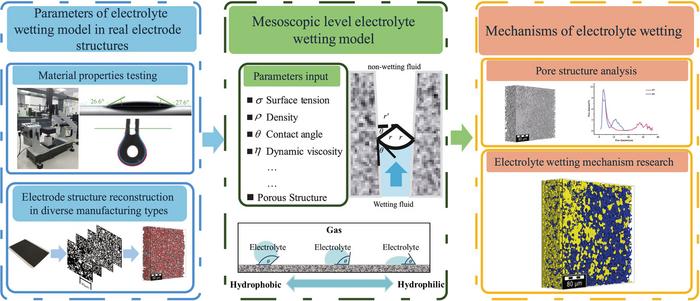
As the world’s reliance on fossil fuels diminishes, there is an escalating urgency to transition towards renewable energy sources, and lithium-ion batteries (LIBs) have emerged as a cornerstone in this shift. The significance of LIBs extends well beyond consumer electronics, permeating through industries that encompass electric vehicles, renewable energy systems, and smart technologies. However, the complexity of large-scale battery construction reveals a significant hurdle—efficient electrolyte filling and wetting processes.
Groundbreaking research initiated by a team at Tsinghua University endeavors to address this critical bottleneck in the realm of battery engineering. The study focuses on the intricate interplay between electrode architecture and electrolyte wetting, two factors that dramatically impact the performance capabilities of lithium-ion batteries. By seeking to understand these relationships more thoroughly, the researchers aim to propel advancements that could enhance the functionality and longevity of these vital energy storage systems.
Central to the study is the use of advanced X-ray computed tomography, a cutting-edge imaging technique that enables the reconstruction of three-dimensional structures within battery electrodes. This sophisticated approach provides unparalleled insights into the microstructural features that govern how electrolytes interact with electrode surfaces. By peerlessly evaluating the dimensions and geometries involved, it becomes possible to pinpoint critical variables that significantly influence electrolyte wetting.
The researchers uncovered that the manufacturing process profoundly influences how well the electrolyte can permeate electrode materials. Specifically, adjustments in calendering pressure—the force applied to compress the electrode layers—along with variations in the active material content, were found to affect porosity levels within the electrodes. This nuanced understanding opens up manifold possibilities for engineers to manipulate the architecture of LIBs during production.
A complex situation arises due to the interactions between porosity, permeability, and capillary action. When calendering pressure is increased or when the proportion of active materials in an electrode rises, the porosity tends to decrease. This reduction can enhance the capillary forces at play, an effect that could improve electrolyte distribution under certain conditions. However, if not managed accurately, this may also impair the overall wetting performance, leaving researchers with a multifaceted challenge to navigate.
The research provided an in-depth examination of the causes behind incomplete electrolyte wetting. Two significant culprits were identified: first, the partial closure of pores, which can happen during the calendering process, restricts electrolyte access. Second, non-wetting phase gases can become trapped in the electrode structures. These gases act as barriers that prevent optimal contact between the electrolyte and electrode materials, limiting the effectiveness of the entire battery system.
Notably, the study in question goes beyond mere qualitative discussions; it integrates quantitative assessments as well. By measuring permeability levels and capillary forces, the researchers furnish manufacturers with empirical data. This information can be strategically employed to refine production methodologies, ultimately leading to more efficient and cost-effective battery manufacturing processes that also enhance performance metrics.
The implications of these findings are significant for the future trajectory of battery technology. By providing a scientific foundation for production optimization, the research opens several promising pathways for engineering advancements that could redefine how lithium-ion batteries are constructed. For instance, one avenue includes the development of optimal geometric configurations for electrodes and separators to maximize surface area and interaction potentials during the wetting phase.
Moreover, the establishment of multi-scale, multi-physics numerical models could facilitate comprehensive modeling of various influencing mechanisms. These advanced simulations would allow for a thorough examination of how multiple variables interact within the complex environments of battery systems. The expectation is that such models could lead to more predictable outcomes in battery performance.
Another fascinating prospect lies in the potential creation of macro-scale process simulation models based on micro-scale insights. As these macro models evolve, they may yield predictive capabilities regarding saturation immersion times that exquisitely align with manufacturing processes, ultimately contributing to reductions in operational costs.
Furthermore, the research introduces a novel idea: implementing vibration inputs during the immersion process to expel trapped gases. This innovation could markedly increase the volume of electrolyte that can infiltrate the electrodes, paving the way for even greater efficiency in battery assembly and performance.
What emerges from this pioneering research is more than just technical findings; it is a call to action for the battery manufacturing community. The study constructively challenges conventional approaches and encourages a focus on detailed microstructural factors that have previously been overlooked. As the demand for high-energy-density batteries continues to grow, particularly in sectors vital to a sustainable future, such as electric vehicles and renewable energy systems, these insights will become increasingly significant.
In conclusion, the comprehensive examination of electrolyte wetting mechanisms yields transformative implications for the manufacturing of lithium-ion batteries. The synthesis of advanced imaging techniques with empirical assessments allows for a profound understanding of critical relationships driving battery performance. This research paints a promising future, suggesting that as we push the boundaries of energy storage technology, improved manufacturing practices could yield an era of more efficient, higher-performing, and reliable battery systems that hold the potential to power our clean energy aspirations.
Subject of Research: Not applicable
Article Title: Unraveling mechanisms of electrolyte wetting process in three-dimensional electrode structures: Insights from realistic architectures
News Publication Date: 17-Jan-2025
Web References: DOI
References: National Natural Science Foundation of China, Shanghai Science and Technology Development Fund
Image Credits: Credit: GREEN ENERGY AND INTELLIGENT TRANSPORTATION
Keywords
Lithium ion batteries, Electrodes, Manufacturing
Tags: advanced imaging techniques in battery researchelectric vehicle battery technologyelectrode architecture optimizationelectrolyte wetting challengesinnovative battery engineering researchlithium-ion battery advancementsmicrostructural analysis of batteriesnext-generation energy storage systemsovercoming battery construction obstaclesperformance enhancement of lithium-ion batteriesrenewable energy storage solutionsTsinghua University battery study





